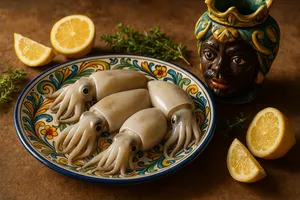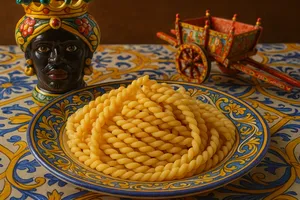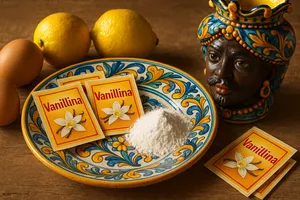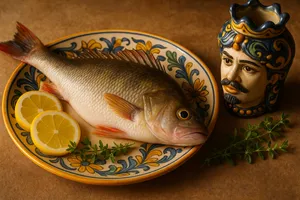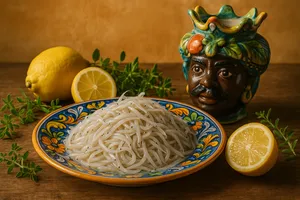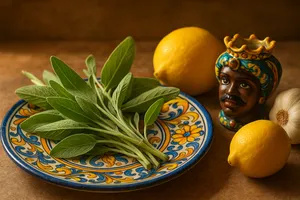Overview
Mutton, known in Sicilian as “carni di castratu” or simply “castratu”, is the meat of a castrated ram, an animal that holds a distinctive place in Sicily’s pastoral tradition. Obtained from males castrated at a young age and slaughtered after 12–18 months, this meat sits halfway between lamb and adult sheep: more flavoursome and structured than lamb, yet more delicate and tender than mature sheep.
In the traditional cuisine of inland Sicily-particularly in the provinces of Enna, Ragusa, Siracusa and Agrigento-mutton features in rustic preparations rooted in the island’s pastoral culture. These are humble yet flavoursome dishes, passed down through generations, reflecting the deep bond between Sicilian shepherds and their animals.
Characteristics
Mutton has a bright red colour, lighter than that of mature sheep yet deeper than lamb. The fat is compact, white to pale pink, and well distributed. The texture is firm without being overly fibrous, with a medium grain that is finer than in adult sheep.
The flavour is robust and characteristic, with herbaceous notes reflecting a pasture-based diet, though less wild and assertive than that of mature sheep. Its aroma is intense-typically ovine but more delicate and pleasant than in uncastrated animals. A good balance between lean and intramuscular fat makes this meat particularly succulent once cooked.
Quality depends greatly on slaughter age and feeding: younger castrated animals (12–18 months) raised on pastures rich in aromatic grasses yield excellent meat.
Cuts
The cuts are similar to those of lamb, but taken from larger animals.
Leg
The most prized cut, ideal for roasting in the oven or on a spit. It may be cooked whole on the bone or boned and rolled with herbs.
Rack
The back with ribs, used for chops. Particularly suitable for grilling or oven roasting.
Shoulder
Less prized than the leg but equally flavoursome, excellent for braises, stews and long, moist cooking.
Breast and flank
Fattier cuts used for boiling or slow-cooked dishes. They benefit from extended cooking times.
Culinary uses
In traditional Sicilian cuisine, mutton is used in characteristic preparations.
Grilled mutton
Chops or pieces of leg are grilled over almond or olive wood and seasoned simply with salt, pepper and wild oregano. The smoky flavour enhances the intensity of the meat.
Mutton broth
A traditional dish of inland Sicily, made by simmering the meat for a long time with aromatic vegetables. The resulting broth is rich and flavoursome, used for soups and risottos, while the meat is served separately with spicy condiments.
Roast mutton
The leg is marinated with wine, garlic, rosemary and spices, then slowly roasted in the oven until beautifully browned. It is a festive dish associated with special occasions.
Mutton stew
The meat is cut into pieces and cooked slowly with onion, tomato, red wine, potatoes and peas, producing a hearty, home-style dish typical of rural cooking.
Cooking
Mutton requires careful cooking to bring out its best qualities. Short cooking methods suitable for milk-fed lamb are not appropriate, as the meat would toughen. Medium or long cooking is preferred, allowing the fibres to soften.
For grilling or pan-cooking, the meat should be cooked over medium-high heat for 5–7 minutes per side, achieving a medium doneness with a slightly pink centre. Roasts and braises require 1–2 hours depending on cut and size.
Marinating with wine, vinegar, oil and herbs is recommended to tenderise the meat and enrich its flavour. A 6–12 hour marinade is ideal for cuts like leg and shoulder.
Storage
Fresh mutton keeps in the refrigerator for 2–3 days in the coldest part, wrapped well in cling film or stored in airtight containers to prevent odour transfer. The surface should be dry before storage.
It freezes very well: portion as needed, wrap tightly and place in freezer bags. It keeps for 4–6 months without losing quality. Thaw in the refrigerator, never at room temperature.
Cooked meat keeps 3–4 days in the refrigerator in closed containers.
Buying tips
When buying mutton, ensure it comes from traditionally pasture-raised animals, preferably in Sicily. The meat should have a uniform bright red colour with no dark or pale patches. Fat should be compact, white to pale pink, well distributed and not excessive.
The aroma must be fresh and characteristic, never sour or unpleasant. The meat should feel firm and elastic, springing back when pressed. Prefer meat from young castrated animals (12–18 months), which is more tender.
Purchase from specialised butchers who stock high-quality meat and can provide accurate information on origin, age and farming methods.
Nutritional properties
Mutton is rich in high-quality protein (around 20–22 grams per 100 grams) and contains 12–18% fat depending on the cut and the animal. Caloric intake ranges from 220 to 280 calories per 100 grams.
It is an excellent source of highly bioavailable iron, important for preventing anaemia, and zinc, essential for immune function. It also contains B vitamins-particularly B12-and minerals such as phosphorus and selenium.
The cholesterol content is relatively high, so it should be consumed in moderation by those monitoring blood cholesterol. Mutton from pasture-raised animals has a better lipid profile, with more omega-3 fatty acids.
Curiosities
In Sicilian pastoral tradition, castration was practiced to obtain more docile animals and superior meat. Male lambs were castrated at 2–3 months, allowing them to grow with characteristics intermediate between lamb and ram.
An old Sicilian saying goes: “U castratu è megghiu d’agneddu e di la pecura” (“Mutton is better than lamb and sheep”), highlighting how this meat was considered superior for its balance of flavour and tenderness.
In many areas of inland Sicily, especially in the Iblei and Madonie mountains, festivals dedicated to mutton are still celebrated today, featuring tastings of traditional dishes prepared according to ancient pastoral recipes.
Mutton broth-known in some areas as “vrodu ’i castratu”-was considered highly nourishing in Sicilian folk medicine and given to the sick and convalescent. Lactating women consumed it to promote milk production.
During Easter, in many parts of inland Sicily, roast mutton replaced or accompanied lamb, providing a more substantial dish suited to feeding large extended families gathering for the holiday meal. This custom remains alive in several rural areas.



